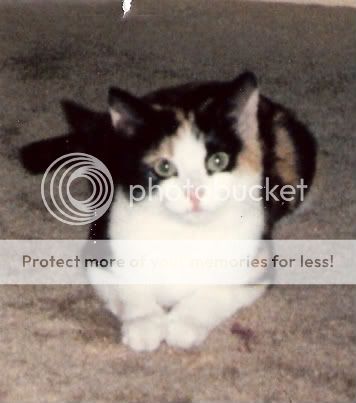This must be stopped
Posted: Wed Aug 27, 2008 3:04 pm
If cats grow wings and learn to fly, squirrels are doomed.
Kinda makes you wonder what's in the pet food.
Kinda makes you wonder what's in the pet food.
NSAS wrote:If cats grow wings and learn to fly, squirrels are doomed.
Kinda makes you wonder what's in the pet food.
RED BULL!!!NSAS wrote:If cats grow wings and learn to fly, squirrels are doomed.
Kinda makes you wonder what's in the pet food.
Is there a Red Hawk drink?etaoin22 wrote:RED BULL!!!NSAS wrote:If cats grow wings and learn to fly, squirrels are doomed.
Kinda makes you wonder what's in the pet food.
Calicos are always femaile. That's not a calico.tanstaafl2 wrote:Must be a genetic anomaly of some sort as calico's are almost always female. Of course if you breed enough of them you are bound to get a few male cats I suppose.
Possibly a cat version of Klinefelter's syndrome which may also predispose the cat to other genetic abnormalities.
Like "wings"...
This is not correct. The male calico is rare and a genetic freak, but it happens. They just have two X chromosomes (similar to what Snoopy refers to with his Klinefelter's reference).Bob Juch wrote:Calicos are always femaile. That's not a calico.tanstaafl2 wrote:Must be a genetic anomaly of some sort as calico's are almost always female. Of course if you breed enough of them you are bound to get a few male cats I suppose.
Possibly a cat version of Klinefelter's syndrome which may also predispose the cat to other genetic abnormalities.
Like "wings"...
OK, I checked that and yes, it's a genetic freak. That's still not a calico cat.Here's Fanny! wrote:This is not correct. The male calico is rare and a genetic freak, but it happens. They just have two X chromosomes (similar to what Snoopy refers to with his Klinefelter's reference).Bob Juch wrote:Calicos are always femaile. That's not a calico.tanstaafl2 wrote:Must be a genetic anomaly of some sort as calico's are almost always female. Of course if you breed enough of them you are bound to get a few male cats I suppose.
Possibly a cat version of Klinefelter's syndrome which may also predispose the cat to other genetic abnormalities.
Like "wings"...
OK, this is odd. I think we might be linking two threads. Check out this definition from Wikipedia. (yeah, I know)Bob Juch wrote:OK, I checked that and yes, it's a genetic freak. That's still not a calico cat.Here's Fanny! wrote:This is not correct. The male calico is rare and a genetic freak, but it happens. They just have two X chromosomes (similar to what Snoopy refers to with his Klinefelter's reference).Bob Juch wrote: Calicos are always femaile. That's not a calico.
admanvii wrote:Male tortoiseshells can occur as a result of chromosomal abnormalities (often linked to sterility)
Egad I hope my tortise shell never goes sterile......Viva Viagra
Whoever wrote that entry is a little confused on some things and over explanatory on others. I think maybe they translated it from somewhere and some things didn't convert.cindy.wellman wrote:OK, this is odd. I think we might be linking two threads. Check out this definition from Wikipedia. (yeah, I know)


I thought we used to joke about them putting the cats in the human food...Gimme A Squiggly wrote:NSAS wrote:If cats grow wings and learn to fly, squirrels are doomed.
Kinda makes you wonder what's in the pet food.
Not again!!! What are those ^#@(@ Chinese putting in there now!?!?!?
I really don't know, she very seldom ever meows. I will sometimes get a disgruntled sound of disapproval when I make her move her bahonka when she'd rather not (which is pretty much always), but that's about it. Her motor runs 24/7 though.minimetoo26 wrote:I thought we used to joke about them putting the cats in the human food...Gimme A Squiggly wrote:NSAS wrote:If cats grow wings and learn to fly, squirrels are doomed.
Kinda makes you wonder what's in the pet food.
Not again!!! What are those ^#@(@ Chinese putting in there now!?!?!?
So, fanny--does Fantine have the "rusty meow"? All the tortoiseshells in our family sound like they need to be oiled.
Here's Fanny! wrote:Whoever wrote that entry is a little confused on some things and over explanatory on others. I think maybe they translated it from somewhere and some things didn't convert.cindy.wellman wrote:OK, this is odd. I think we might be linking two threads. Check out this definition from Wikipedia. (yeah, I know)
A true calico is white, black and orange, with the black and orange in blocks of colour. This is demonstrated for us here by our lovely model, Chloe:
A tortoiseshell can be variations of those colours (cream, brown, etc.) and is mottled or swirled rather than patches. Representin' for all the torties out there is the ever charming Fantine.
Mini the Ignorant Slut wrote:Oh, Fluffy--you're the REAL slut around here....
My eyes are yellow. Not glowing demon yellow, more amber. My grandma used to call them cat eyes. They are not hazel, but I usually put down hazel for eye colour because that's the closest default. Someone told me that only Italians and mulattos could have yellow eyes, which seemed odd. So I started reading up on the subject (this was pre-internet so I actually had to check out books from the library and everything. Wow!)christie1111 wrote:Chloe and Fantine are lovely cats! Great picture of Chloe!
Are your eyes the same color? I was wondering what color would be unusual enough to interest you in genetics. Someone who used to work here had very changable eyes. Blue/gray that would easily pick up the color of what she was wearing.
Here's Fanny! wrote:My eyes are yellow. Not glowing demon yellow, more amber. My grandma used to call them cat eyes. They are not hazel, but I usually put down hazel for eye colour because that's the closest default. Someone told me that only Italians and mulattos could have yellow eyes, which seemed odd. So I started reading up on the subject (this was pre-internet so I actually had to check out books from the library and everything. Wow!)christie1111 wrote:Chloe and Fantine are lovely cats! Great picture of Chloe!
Are your eyes the same color? I was wondering what color would be unusual enough to interest you in genetics. Someone who used to work here had very changable eyes. Blue/gray that would easily pick up the color of what she was wearing.
Back when I wore contacts, I had two different coloured eyes. They used to put a light blue coating on the left one to tell them apart. In most people it wouldn't change their eye colour, but with mine it turned my left eye green (blue plus yellow equals green!).
You can ask Luuucy about this. She was fascinated and inspected them at close range. Well, as far as she could bend down, anyway. Ha!
Still? They're not THAT fascinating.cindy.wellman wrote:Here's Fanny! wrote:You can ask Luuucy about this. She was fascinated and inspected them at close range. Well, as far as she could bend down, anyway. Ha!
I still am fascinated!
9 out of 10 calicos are either named Patches or Callie/y. It's the "Snowball Law".Fluffy wrote:As another proud torty (Hey, I didn't realize we had our own group... cool!), I recall having several kittens that looked like the one shown up above, including one that actually stuck around a while that Beast's sisters named Patches. Patches was a she....
I love the genetics lesson. You probably coulda learned a lot from me back in the day....
Sheesh -that word again, within 24 hours! What are the odds?cindy.wellman wrote:or by a phenomenon known as chimericism, where two early stage embryos are merged into a single kitten